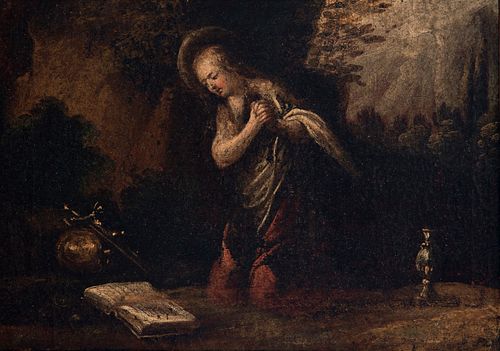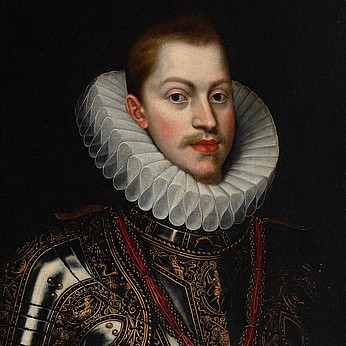Spanish school of the seventeenth century. Attributed to FRANCISCO ANTOLÍNEZ Y SARABIA (Seville, around 1645 - Madrid, 1700). "Penitent Mary Magdalen
Lot 42
About Seller
Setdart Auction House
Carrer Aragó 346
Barcelona
Spain
Setdart Subastas was born in 2004 and is currently the first online art auction in Spain with solidity, prestige and reliability guaranteed by our more than 60,000 users. Setdart has a young, dynamic and enterprising team ready to successfully manage the purchase and sale of art works through custom...Read more
Estimate:
EUR€3,000 - EUR€3,500
$3,125 - $3,645.83
Absentee vs Live bid
Two ways to bid:
- Leave a max absentee bid and the platform will bid on your behalf up to your maximum bid during the live auction.
- Bid live during the auction and your bids will be submitted real-time to the auctioneer.
Bid Increments
| Price | Bid Increment |
|---|---|
| EUR€0 | EUR€10 |
| EUR€200 | EUR€25 |
| EUR€500 | EUR€50 |
| EUR€1,000 | EUR€100 |
| EUR€3,000 | EUR€200 |
| EUR€5,000 | EUR€500 |
| EUR€10,000 | EUR€1,000 |
| EUR€20,000 | EUR€2,000 |
| EUR€50,000 | EUR€5,000 |
About Auction
By Setdart Auction House
Nov 24, 2021
Set Reminder
2021-11-24 09:00:00
2021-11-24 09:00:00
America/New_York
Bidsquare
Bidsquare : Old Masters, Day 1
https://www.bidsquare.com/auctions/setdart-auction-house/old-masters-day-1-7873
Setdart Auction House sofia@setdart.com
Setdart Auction House sofia@setdart.com
- Lot Description
Spanish school of the seventeenth century. Attributed to FRANCISCO ANTOLÍNEZ Y SARABIA (Seville, around 1645 - Madrid, 1700). "Penitent Mary Magdalene". Oil on canvas. With label of the Service for the Defense of National Artistic Heritage. With label of Inventory of the General Directorate of Fine Arts. Measurements: 31.5 x 43 cm; 46 x 58 cm (frame). In this canvas, close to the aesthetic precepts of Francisco Antolínez, Mary Magdalene is represented as a penitent in the desert (not understood in the scriptures as such but as an isolated and uninhabited place), dressed in a simple sackcloth, probably barefoot, accompanied by her iconographic attributes; such as the crucifix, the sacred scriptures and the skull. Formally, the work combines the contrasting light treatment, chiaroscuro and based on earth tones typical of the period with a conception of the figure and the composition directly derived from the Sevillian school. The present painting shows elements inherited from the Baroque period, however, the softness of the forms, the measured composition and a certain luminism, show us the aesthetic advance of the painting, resulting in a more measured image, in which we are presented with a Mary Magdalene, reflective and not the dramatic image of the character. Brother of the painter José Antolínez, Francisco was a lawyer by profession, although his curiosity would lead him to become interested in many different subjects. He was thus introduced to the practice of painting, obtaining success with small format works generally starring small figures against a background of landscape or architecture. Ceán Bermúdez noted that after studying law in Seville he learned painting at Murillo's school, attending the academy established in the Casa Lonja of the same city, where he was recorded in 1672. That same year he must have moved to Madrid to meet with José Antolínez, although it is probable that after his death he returned to his native city for some time. Finally he will settle definitively in Madrid. Francisco Antolínez was able to make a living from painting, but in spite of this he did not sign his works, since he preferred to present himself as a lawyer. Antolínez shows himself to be heir to the Flemish style of Ignacio de Iriarte in his landscapes, and in the architectural backgrounds of Matías de Torres. Regarding his figures, they denote a clear Murilloesque character. Francisco Antolínez is currently represented in the Prado Museum, the Castrelos Museum in Vigo, the Provincial Museum of Ciudad Real, the Episcopal Palace of Huesca, the parish of Santa Ana de Brea de Aragón, the church of Nuestra Señora de los Remedios in Zamora and other religious centers, public and private collections, etc. The author has conceived work that is completely dominated by the landscape, which becomes the protagonist of the image.
- Shipping Info
-
In-house shipping available. Please inquire at admin@setdart.com.
-
- Buyer's Premium



 EUR
EUR CAD
CAD AUD
AUD GBP
GBP MXN
MXN HKD
HKD CNY
CNY MYR
MYR SEK
SEK SGD
SGD CHF
CHF THB
THB


















